The trees are coming into leaf like something almost being said, The recent buds relax and spread
Tuesday, April 30, 2019
The words in the headline of this News item come from the poem
"The Trees" by Philip Larkin which for me always seems most
appropriate for the arrival of Spring and in particular the month
of April. The exact timing of which depends upon the weather.
Last year it was later thanks to the Beast from the East, but this
April a favourable mix of weather provided perfect conditions for
all manner of plants to get going, the most significant of all
being leaf break on trees and shrubs, transformed almost over night
skeletal shapes.
The oaks are collectively earlier than ever, and
in the old weather lore rhyme - oak before ash summer will be a
splash (of rain), Ash before oak we are in for a soak. Sadly
the ash are dying in their hundreds all around us so no competition
for years to come. Notwithstanding this, I guess summers will
be as unpredictable as ever!

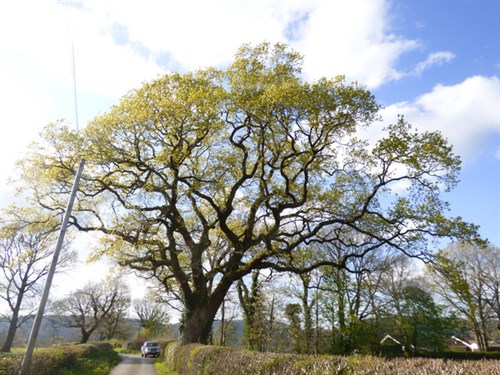
Acers are fabulous and the foliage of "Orange
Dream" as beautiful as ever
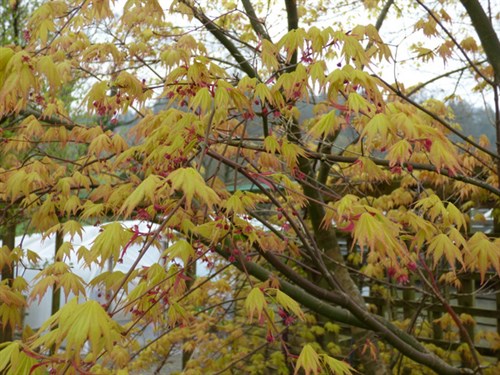
Not far away is this acer (name unknown) with red
buds yet to open.
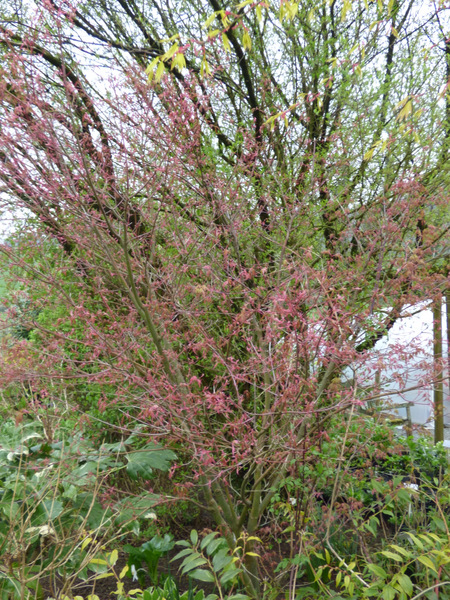
The poem is an interesting one to to read as it subtly
juxtaposes the life of trees with that of us humans. The ageing
process is a common feature of many of Larkin's poems as you may
well know if you are familiar with his work. To read the poem
"Trees" in its entireity go to
www.allpoetry.com/The-Trees
Interestingly I recently read unatributed comments from a
member of the Woodland Trust, that in the UK, Spring is
coming 2 weeks earlier than 30 -50 years ago, and autumn about a
week later. Many trees such as oak, horse chestnut and sycamore are
coming into leaf much earlier. That is certainly the case this
month.
Sheep take refuge under the spreading (horse)
chestnut tree

In just a few days the tree was covered in its magical
candle flowers

As always it has been a very busy month with much to do all over
the gardens, all of which we have done much sooner than usual,
having got off to a good start with fine weather in March. There
are lawns to feed and regularly mow, ponds to clean out and refesh,
borders to turn over and new plants to fill gaps, and the
vegetable garden to get ready for planting and sowing.
3 years ago this lawn in the House Garden was our
biggest veg garden, but to save work we planted grass seed which
has done very well- it should do as I always considered it the best
soil in the garden!
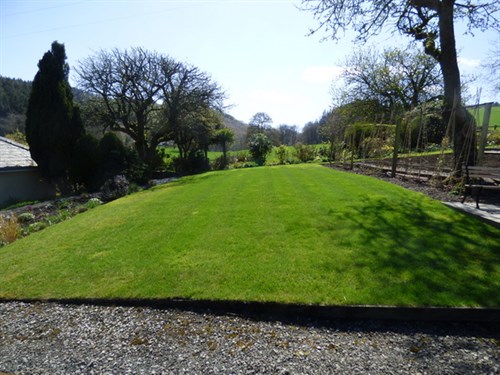
The dirty Paddock Pond - after a days work it is
now pristine
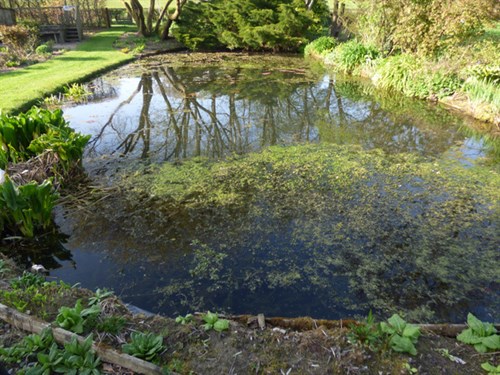
The nursery is a scene of constant activity with many seedlings
to pot on, more seeds to sow, large pots to split and replant, much
of which is Moira's domain.
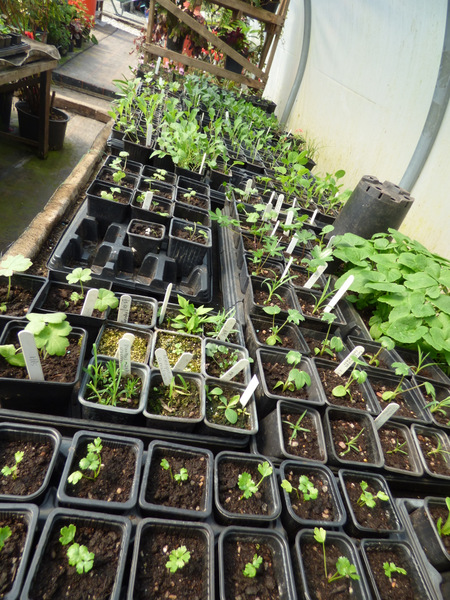
Weather
After a shock start to the month with snow on the first few
days, and cold nights with a couple of moderate night time frosts,
there was some welcome rain and warmer conditions building up to a
crescendo of much hotter days which was most welcome, towards the
latter part of the month. Easter was very enjoyable in most
parts of the UK. The one overall defining weather condition, as
often is the case at this time of year, was a consistent
easterly air flow with some fairly strong and chilly winds at
times
Weather Stats
Snow briefly on 3rd and 4th of the month
Sunshine days =15
Rain = 5
Changeable = 10
Temperatures:- Max25.3 on 21st
In all 5 other days over 20C
Min. -1.3 on 11th Only 2 frosts all month
Rainfall = 2" In curiosity I researched the average
rainfall for Llangadog and discovered April is the driest month of
the year with an average of 2.32 inches so the month was not as
extraordinary as I first thought.
The stream that feeds the Paddock Pond, but not at
present with such low monthly rainfall
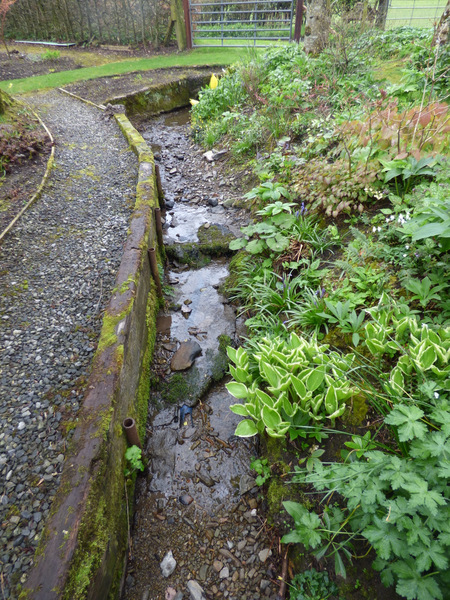
Land of the long white cloud a long way from
NZ.
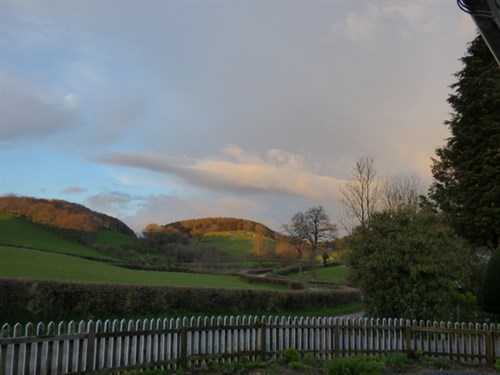
Dawn at 5.00am

Rising full moon over Cilgwyn Forest
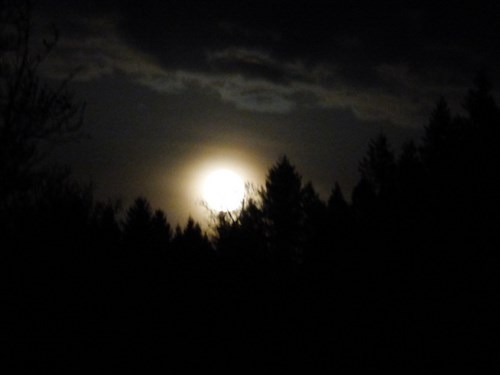
Garden Update
Preparing the veg. garden is always a key priority and once it
is rotavated and the soil in a good condition, sowing and
planting can begin. We were even earlier than usual at the
beginning of March when fine weather permitted planting of the
onion sets which are now growing strongly. Sturon and Red Baron are
our 2 favourites, although last year due to a mix up in the nursery
where I bought them loose, I ended up not with Sturon, but with
what turned out to be Stutgarter, a rather flat onion, both awkward
to prepare for cooking and difficult to string up tidily for
storage

There is something about the fresh smell of newly
turned earth, which is akin to opening the doors of polytunnels and
greenhouses first thing in the morning. It gives me a chill up the
spine. Until a few weeks ago I didn't give this any more thought
until Julian, a friend of ours, posted a blog on his website
drawing attention to a word I had never previously heard of-
Geosmin. As a graduate from Cambridge University, Julian is
always coming up with examples of oddities like this from the
natural world. To find out more information about Geosmin go
to www:://en.wikipedia.org/wiki/Geosmin
One final interesting point of note is that perfume companies have
discovered the perfume potential of geosmin with some on line
offerings priced in the region of £250.!!
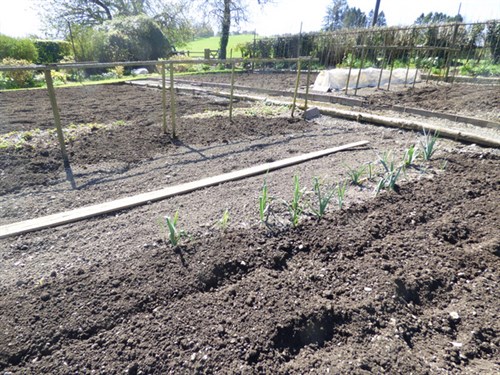
The vegetable beds are some of the stoniest in the
garden - it is the same every year but incredibly we can still get
good crops even of tap rooted veg like carrots and
parsnips.

Seed sowing begins.
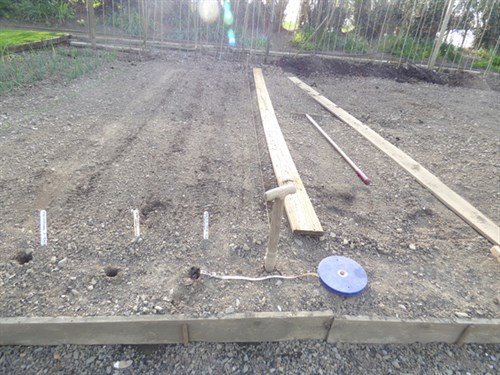
For the first time since my illness, well rotted farmyard manure
was spread onto the veg beds which have not produced the best crops
for some years. This was made possible by Matt a friend who did all
the heavy work. I hope that this will help beneficial soil
microbes to once again become established.
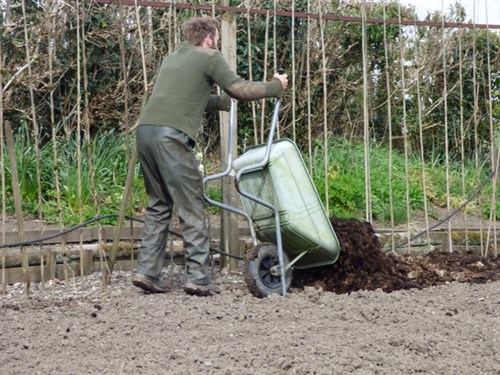
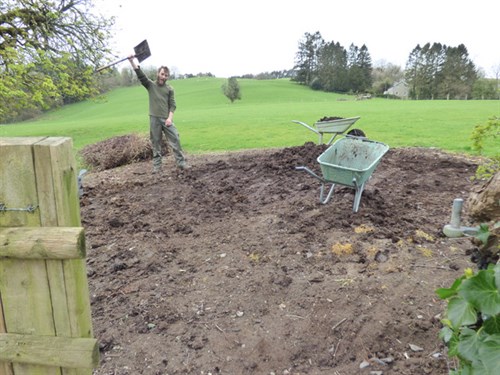

The last crop of parsnips "White Gem" was taken from the
garden before preparing the veg beds

Since the latest spell of warm weather all the potatoes (salad
types) and small seeds of root crops have been sown, peas and broad
beans too; lettuce plants and Hispi cabbage are already growing
well under fleece. More sowings and plantings will be made later
for continuity, and runner beans, sweet corn and corgettes are
growing away in the tunnels for planting out when the risk of
late frost has passed.
All flower borders are largely weed free following my regime of
spraying them with weedkiller a couple of months ago, saving
much time consuming and tiring work. They have also been
turned over, where possible using a mini cultivator.

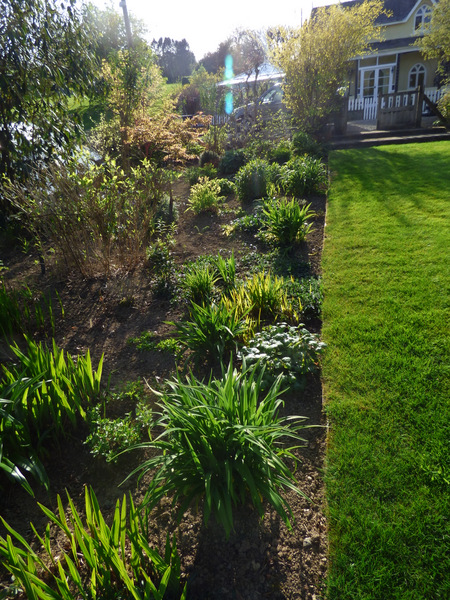
What's looking good?
The characias hybrid euphorbias continue to shine out
with their fresh green bracts and at 5 feet plus tall make a
teriffic statement. A nice contrast with this vibrant evergreen
azalea some feet away.

From a different angle to the previous pic we can see the
emerging flowers of dwarf rhododendron "Bow Bells" alongside
the picket fence at the entrance to the house.

Mgnolias are still hanging onto a few flowers and are now
greening up. Viburnums in variety are flowering well as are the
atragene clematis I mentioned in the previous month's news.
Viburnum carlesii with a wide ranging
perfume

This unique early leaf colour belongs to a cultivar "
Sargentiana Onondaga". Followed by white lacecap flowers. One of
several in the gardens as they do so well for us.
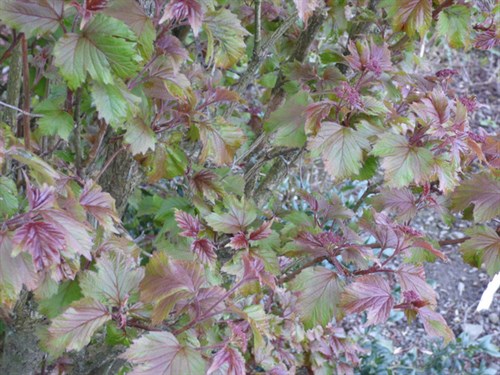
Grown from seed from The British Clematis Society a good
few years ago and labelled as an unknown alpinum form, it is
an absolute gem and much admired for its large deep blue flowers
and floriferousness
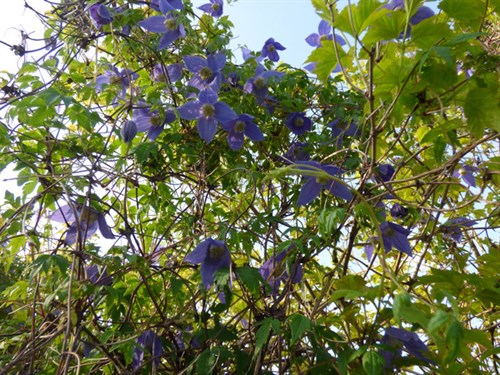
Along established clematis macropetalla "Markhams
Pink' is also a very floriferous flowering form in the
atragene section of clematis.
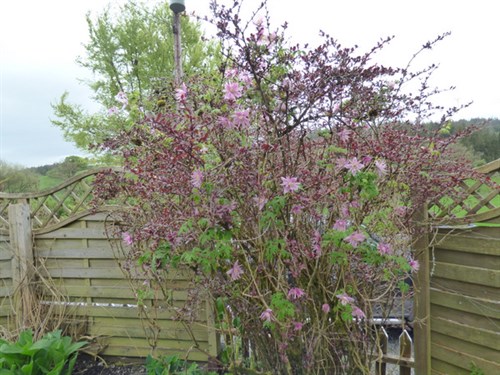
Podophylum versipelle "Spotty Dotty" an increasingly popular
plant for humus rich soil in shade or part shade. Attractive
pendant red flowers in late May. When established I find that It
runs but not too invasively. The leaves around the plant are the
remains of the mulch that protected it from from earlier
frosts
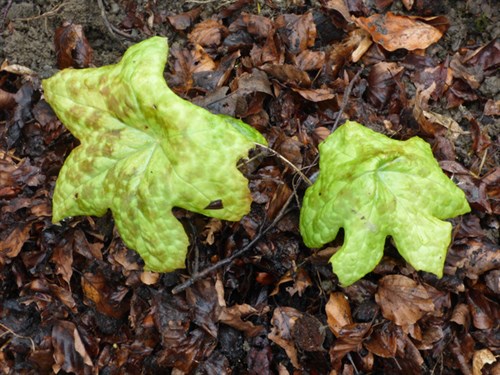
Bluebells and erythroniums

Possibly my favourite erythronium californicum "White
Beauty" the so called trout lily.
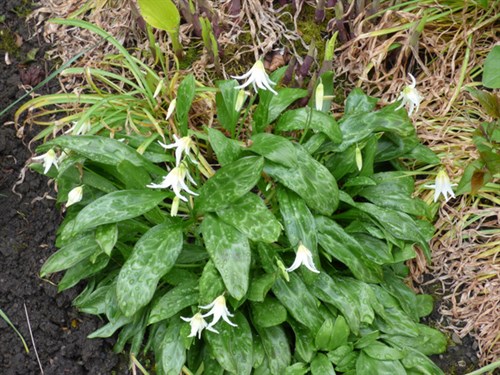
Hosta albo marginata has a special place in
our ever increasing
collection of hostas. It was in the garden here when we first
arrived all those years ago. The original mother plant was split
many times and the divisons are scattered all over the
garden. It is still one of the easiest and best of the green white
edged forms of which there is plenty of choice.
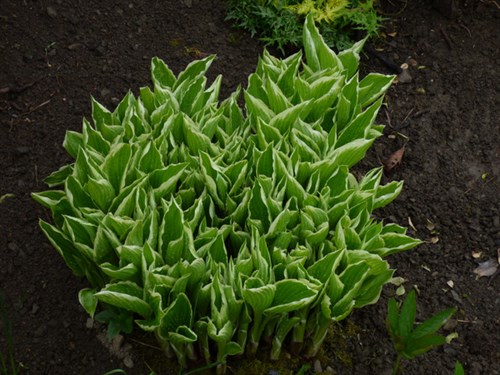
Part of the woodland garden with brunneras to the
fore, keeping the blue theme going after the pulmonarias and before
the bluebells

Hydrangea anomala subsp. petiolaris growing up the frame
of a dead acer, and it is the first year it has produced such a
crop of buds. Covering with fleece during colder nights of
the past 2 months has protected them.
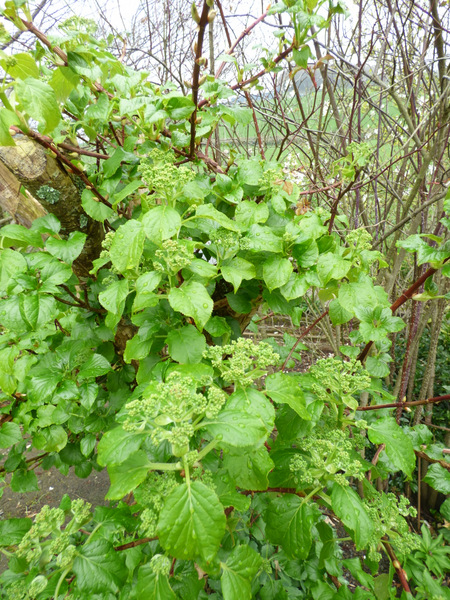
I have praised the beauty of new leaves on shrubs and
trees but some herbaceous will give them a run for their money. The
gloriously ridged and felted leaves of veratrum is a good example,
but it is very slow to flower so it has to do something to make up
for it.This one has been in the garden for 7 years without
flowering.
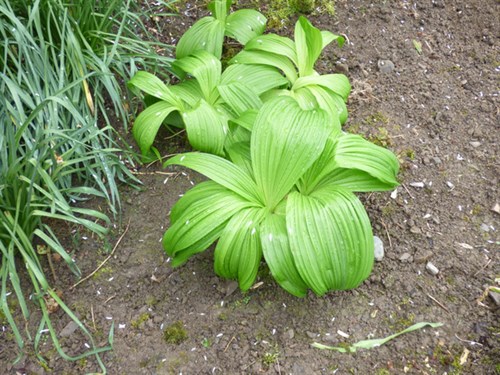
Hosta like leaves on cardiocrinum giganteum are
also attractive but unlike the veratrum once they are established
like this offset, they flower well and when that flower dies
another bulb will take its place. I am reliably informed by Joseph
Atkin the Director of Aberglasney Gardens who has seen them in the
wild in the Himalayas, that this process of renewal can be repeated
for up to a hundred years!!
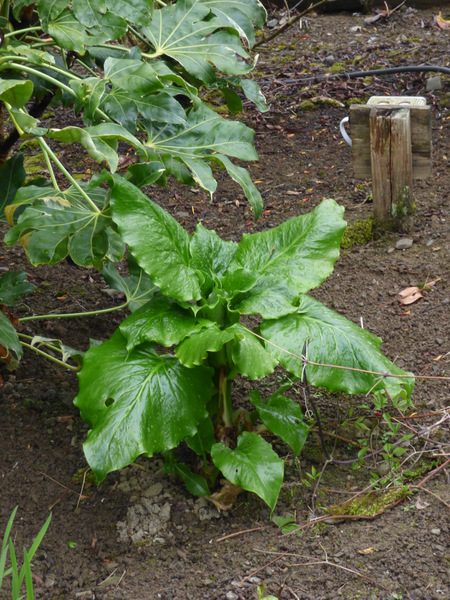

Arisaema nepenthoides, the first in this fascinating
genus to flower in the year.
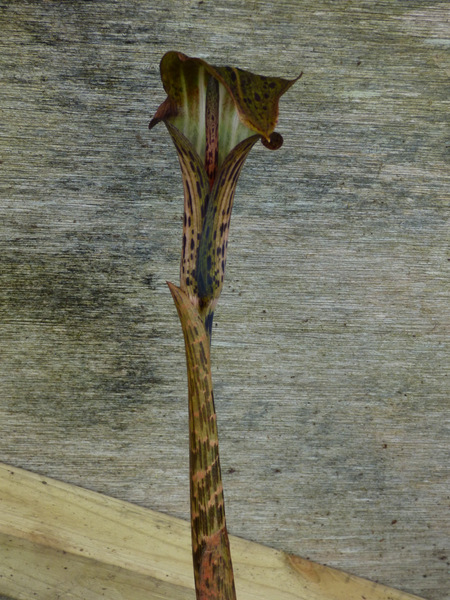
Chloranthus fortunei, a single family genus is an
unusual plant for shade and humus rich moist soil. Priced at over
£25 on some websites it is a plant to treasure so that is what I
have done in the 6 years or so I have had it, molly coddled in a
poly tunnel. I must bite the bullet soon and plant it in the garden
this year
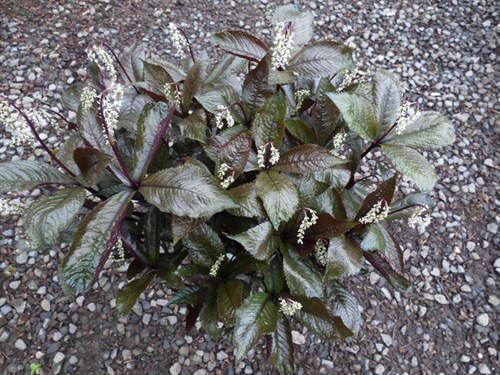
It is always a red letter day when peony "Molly the Witch"
(easier to pronounce then its true name of mlokosewitschii)
For me it rarely ever has more than a few flowers in most
years. It is the palest lemon yellow flower which the picture does
not fully convey. A true species form which stays in flower for
just a day or so.! Always expensive to buy but much admired.
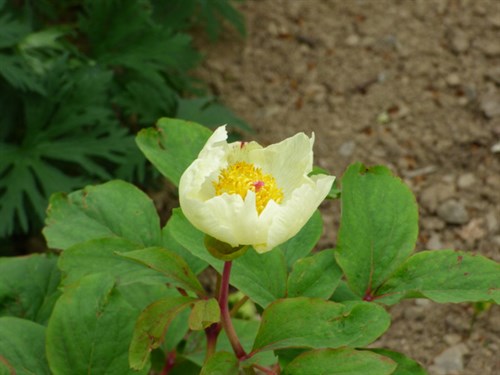
Wildlife and countryside
Wherever you look in fields, along the lanes and roadside
verges, there are wildflowers to admire; wood anemones, primulas,
daisies, ladies smock ( meadow pratensis) and dandelions, rank weed
that they are, but they provide masses of colour which if you don't
like yellow flowers is a big turn off!. Bluebells also share
similar habitats showing that they don't only grow in woodland. On
that subject the local woods that are normally full of bluebells,
were quite slow this year in spite of weather favourable to
them.
Primroses on a drive to a cottage on one of our
travels

Wood anemones on a bank just up the lane from us,
flowering much better since the hedge was laid last
year,

A simple combination of daisies and dandelions on
a green swathe in the village of Llanwrda. If you are not familiar
with the Welsh language, try pronouncing that!
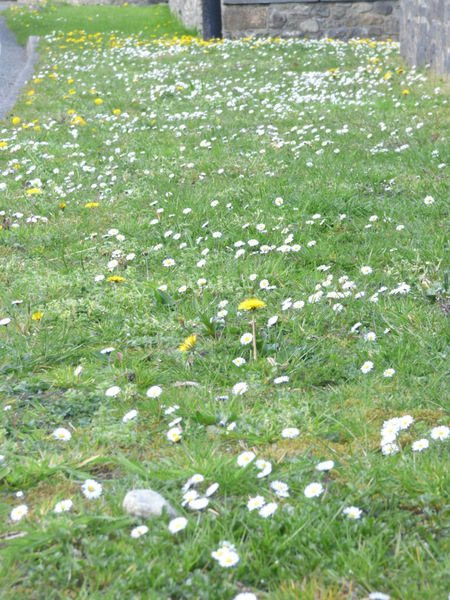
No introductions necessary for these little
beauties in a hedge. You have got to keep your eyes open on a
walk.
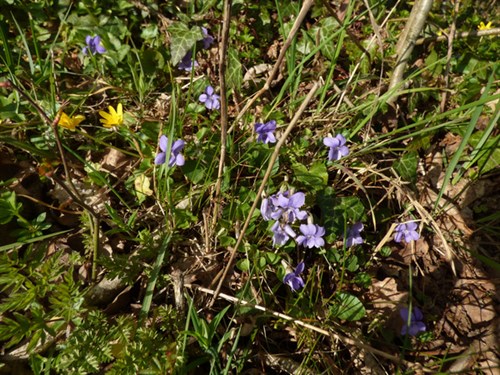
.
I guess that like many other gardeners we
have native arums, often called Lords and Ladies in
common parlance, all over the garden here, many of which are weeded
out before they have chance to seed around. But if you leave a few
better forms ( they are fairly variable) you will be rewarded with
flowers like this for a short while with a pale pink spathe and
black spadix. This one right outside the kitchen
window
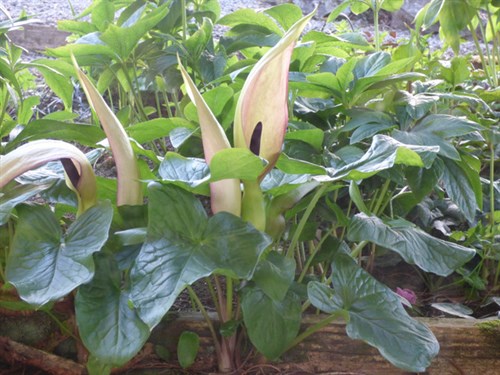
Bluebells ringing the boundary of this oak
woodland just across the valley, about 300 yards from
Cilgwyn
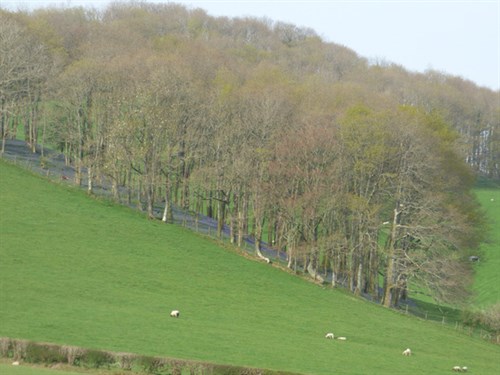
After a slow start they are now everywhere you
look - especially in woodland where you normally expect to find
them. Looking through the canopy of oak trees like an impressionist
painting.
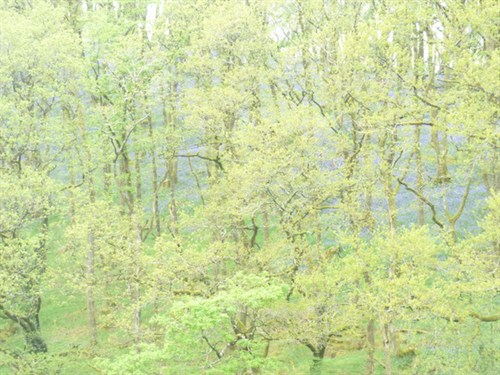
In a ditch alongside a country road

Or in the middle of a field in full
daylight
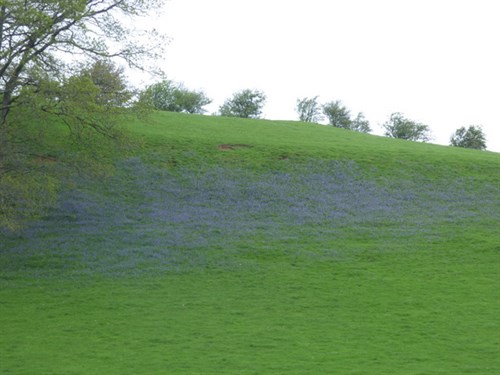
In a stellar cast, the real wild flower stars this year
however have been a range of primulas, in a variety of colours in
the case of primula vulgaris the classic and much loved
primrose.
Some of these are as white as they look which is a
rgularly encountered colour break from the usual pale
yellow
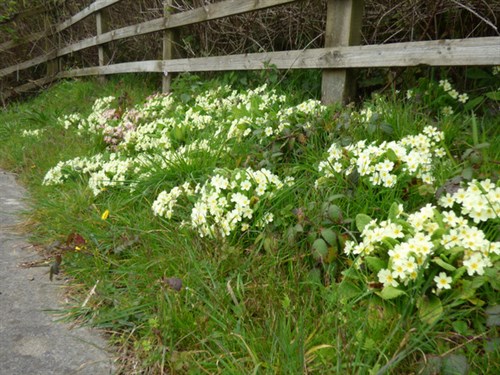
Pink forms are more regularly encountered in a
range of shades
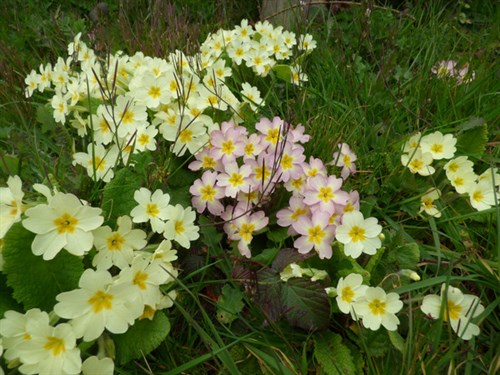
Having researched how this pink colour break
comes into being I have drawn a blank with several conficting
opinions dicussed on the Internet. Some say they are cross
pollinated by bees which have previously visited the wild primroses
from cultivated forms in gardens, and others that it is due to a
high presence of anthocyanins red pigments in the cell
structure of some plants.
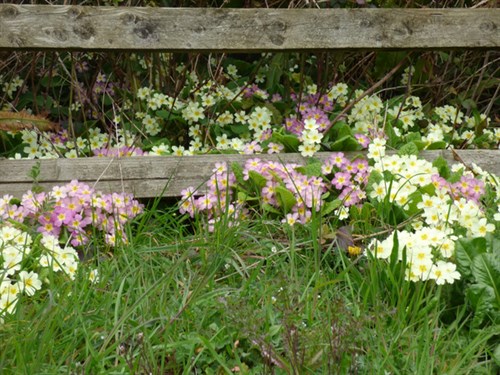
The primrose mystery continues with this form on an
embankment some distance down the A40 from the primroses above. The
A40 over the years has turned out to be quite a wildlife and
wildflower corridor and you need to keep your eyes open when
driving along it, but only as a passenger of course!
But back to the current picture below. It is a
cross between a cowslip and a primrose. This is not an uncommon
cross and usually has a single flower stem with pendant flowers on
one side of the plant which this one clearly hasn't. This cross is
called an oxlip with a biological name of primula elatior. I could
not find a single example of this on the site.
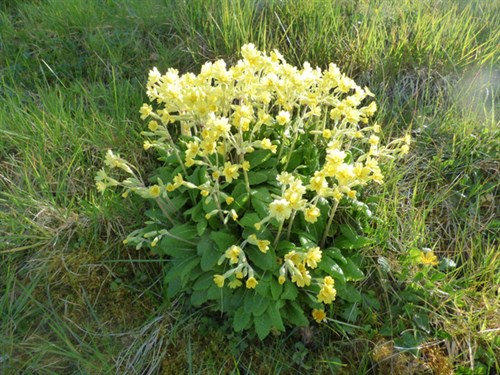
However in the case of the multi
headed form it is a false oxlip with a botanical name of primula
polyantha, which is totally appropriate as it represents a
cultivated polyanthus, that long stemmed primrose of gardens and
many municipal plantings, as they stand up tall to make a better
impact

Sloe (blackthorn) flowering was magnificent all through
most of the month, especially in hedgerows, thanks to those people
who planted them many years ago. In the line of another poem
that came to mind " They planted well that we may do better". All
this and sloes to harvest later in the year.
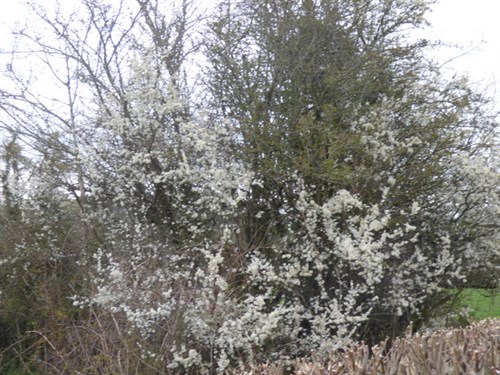
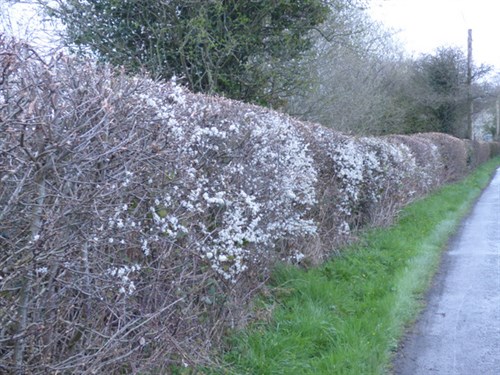
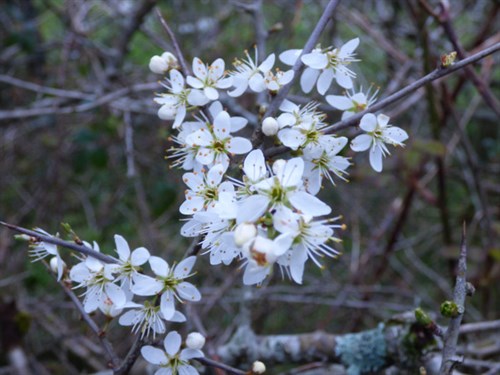
A real spring highlight is the first arrival of swallows which
ocurred here on 10 April when 6 flew over the gardens and
they have been quite common since then. Although a couple of
swallows are said not to make a summer, I am confident that 6 all
at once is a good omen!!
A rare bird sighting or should I say sounding, was of a goshawk
flying over the large fir trees early in the morning, where the
magpies are nesting. Moira also saw the goshawk a day earlier in
spectacular aerial combat with a couple of red kites which beat a
hasty retreat.
Back to the "sounding" it was the goshawk call that alerted me
to its presence. To learn more and hear the call that alerted us go
to www.british-birdsongs.uk/northern-goshawk/
At Easter with the warm spell of weather, butterfles were on the
wing, orange tips and totoiseshells in particular, as were all
manner of bees, attracted to the the flowers on lamium orvala an
attractive member of the nettle family.
it is always the same whenever you want to take a pic of
insects on a flower, they invariably take off just before you have
a chance to click the shutter!!
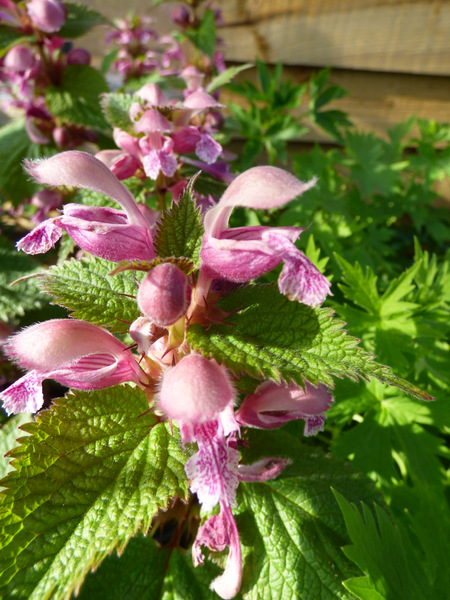
On this occasion I was fortunate enough to
stumble across an orange tip resting on a flower of cardamine
pratensis , ladies smock. I never realised how beautiful are the
undersides of their wings which you so rarely see when they are in
flight.
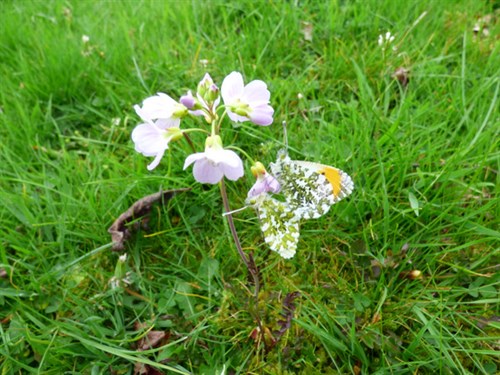
Visits
Somehow we found the time to go to Aberglasney Gardens which I
frequently rave about, April being one of the best times to go as
there are many woodland and shade areas to explore, and
many fine flowering trees and shrubs in wide variety too.

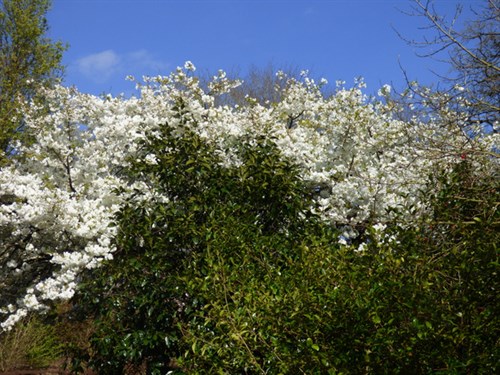

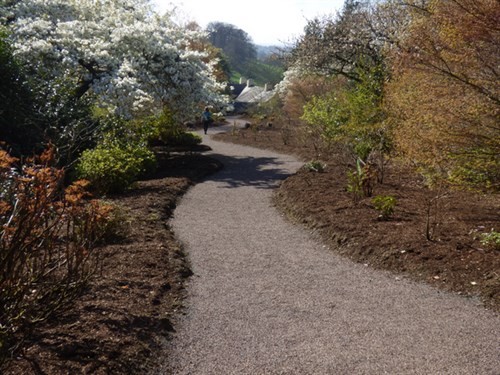

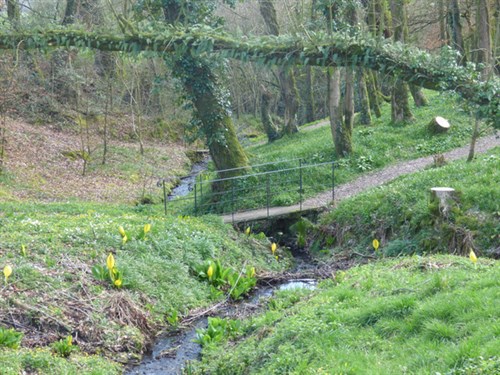
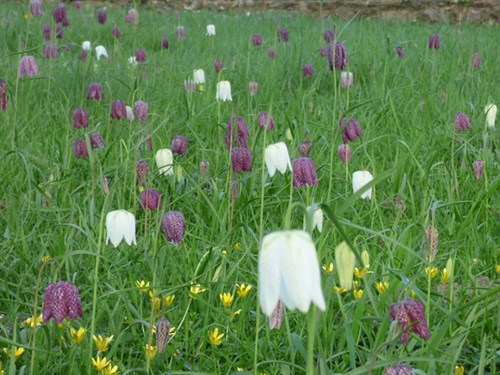
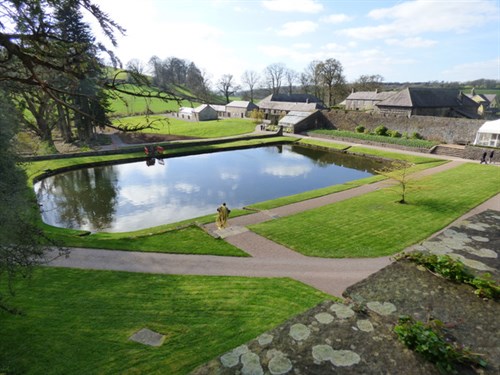
At the beginning of the month we were invited to an event run by
the Carmarthenshire and Pembrokeshire region of the National
Gardens Scheme, and to sell our plants . Although we no longer open
we still feel part of the NGS family and are so pleased to be
made welcome by all the current participants, and the County
Organiser Jackie. The event was held at Llwyn Garreg, Llanfallteg,
Whitland, Carmarthenshire owned by our friends Liz and Paul
who are superb gardeners of this marvellous 3 acre garden.
Moira was in charge of plant sales. She is more charming
and persuasive than I am!


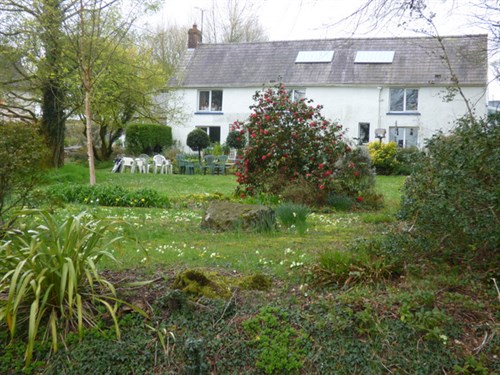
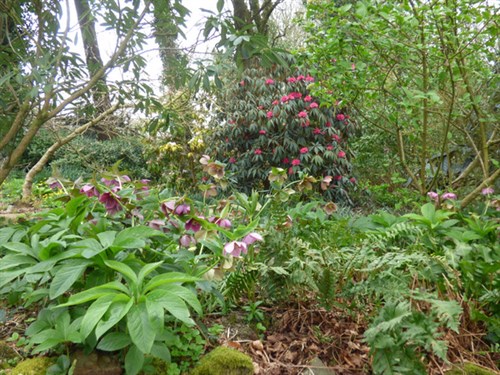

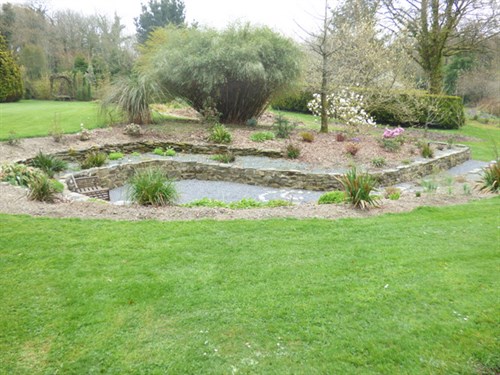
Soldanella in a number of forms is a choice alpine
for early spring.
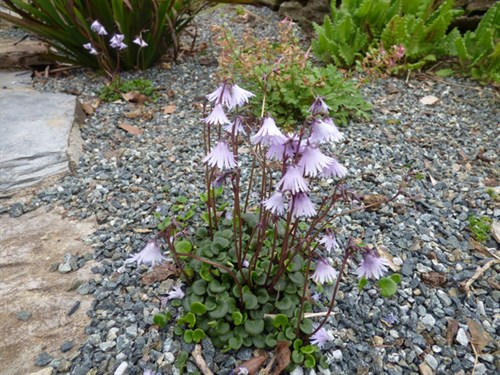
Paul and Liz have excellent soil, and
such a good climate with protection from surrounding trees, that
any plants we have that we struggle to grow are passed on to them.
The main plant in this pic is euphorbia x pasteurii a chance find
at Oxford University Botanic Garden believed to be a cross from 2
parents, E. stygiana and E.mellifera. It makes a shrub like
specimen in excess of 7 feet with the usual euphorbia bracts in
flower. It is always good to see plants that you have donated
growing so well. We can't wait to go back when the flowers
arrive
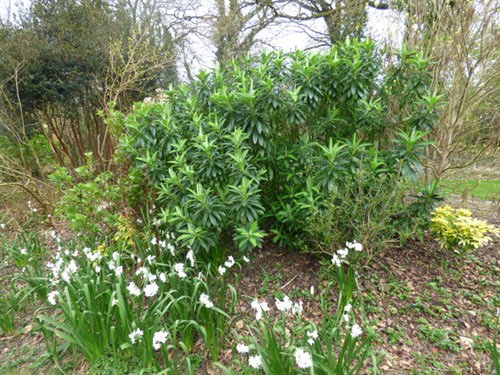
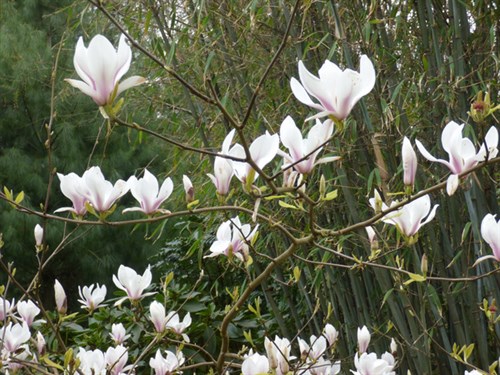
Costant seed sowing over the years has produced
this fine collection of massed fritillaries, in long grass and
lightly dappled shade.
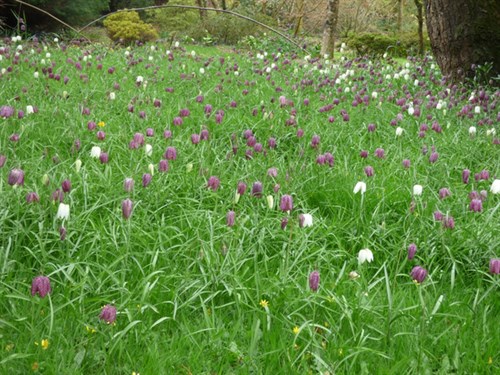
A fairly recent addition to the garden is this
Chinese bridge made in steel by Paul's brother.It straddles a
little stream and and is an attractive entrance and exit to the
main garden.
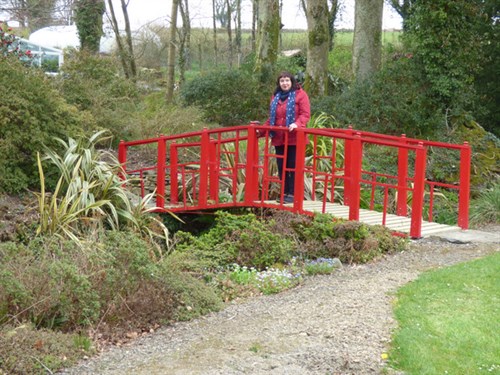
To visit this superb garden which we highly recommend to
you dear reader, visit the website for opening times and
directions at www.llwyngarreg.co.uk
The first RHS show of the year is held in Bute Park,
Cardiff every year in the middle of April, and is one we look
forward to as it is the closest RHS show to where we live. It is
also an occasion to meet up with our friends in gardening,
many of whom we don't see that often so it is a very full
day. A smaller show than most RHS Shows it is in a lovely
situation in the middle of Cardiff with a good range of
stallholders and other attractions with an
empasis on a fun day to appeal to all age groups. Children are
encoraged to paticipate through their schools with a wheelbarrow
competition which is imaginative fun. There is always a great local
atmosphere and a warm Welsh welcome.
Most pictures need no text but I have named a few of the
plants on display

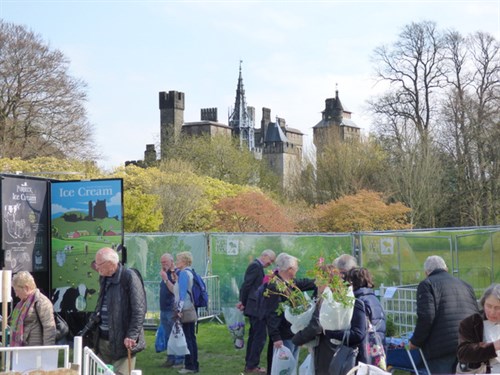
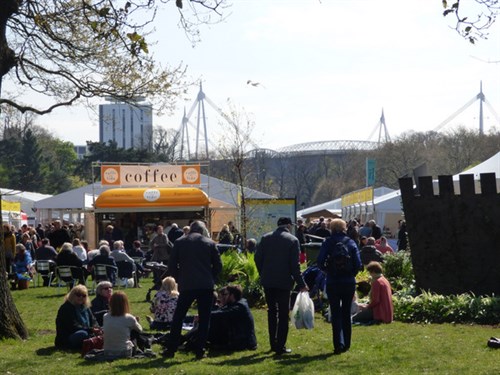
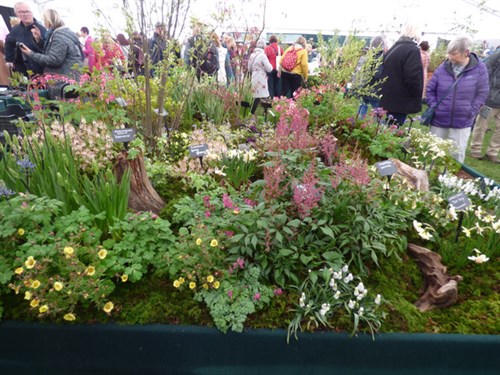
A great time of year to show off primula
sieboldii, this group from a National Plant Collection
holder

Arisaema sikokianum, really difficult to grow at
the best of times, but quite an achievement in early April. Always
expensive to buy!
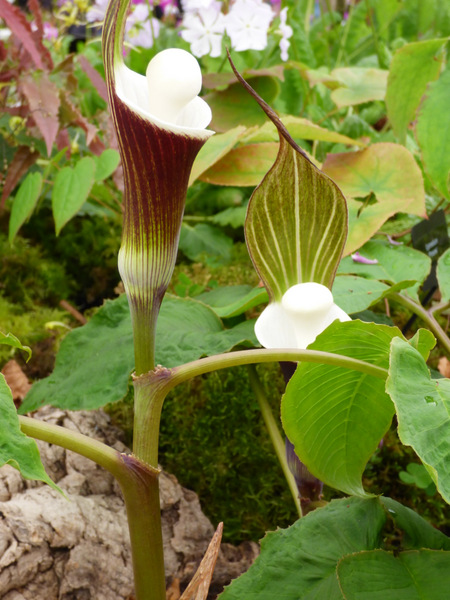
Auricula theatre
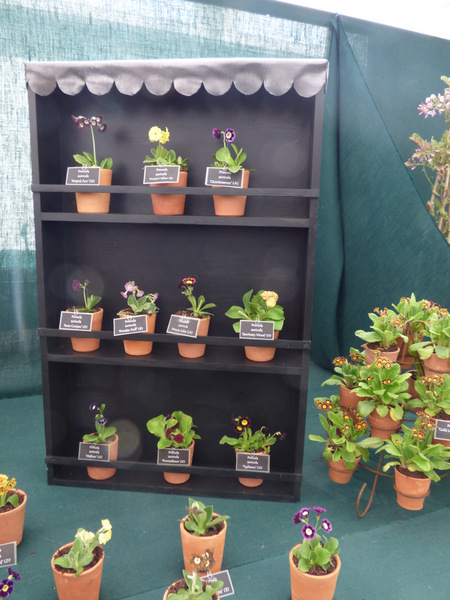
Many stallholders had this echium for sale which at
£25 or so prevented me from looking too closely into what its name
is! lest I was tempted.
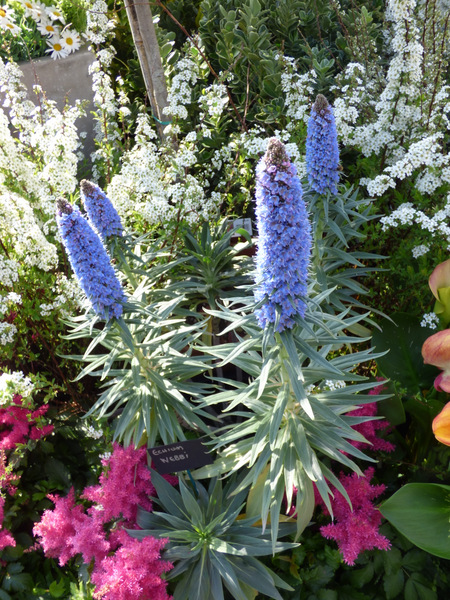
Bill and Ben in their plant pots paraded all
around the showgroiund
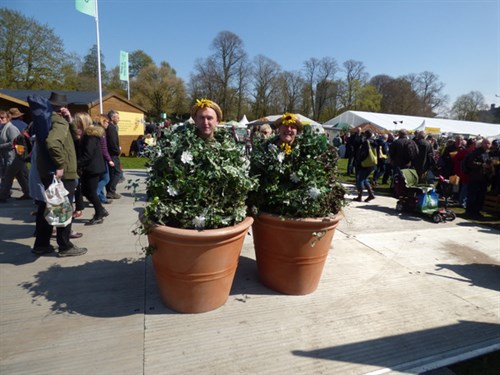
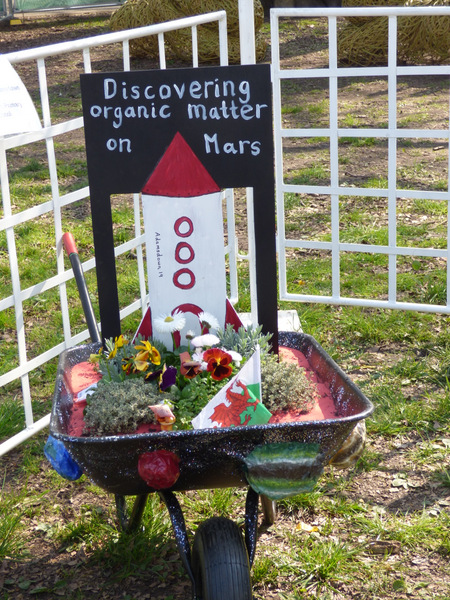
Cute Teddy bears made from artificial lawn turf. Rather
large to take home, with most visitors either on coaches or trains
or having to park some way from the showground. And you would need
deep pockets to afford them.

Thanks for reading and have an enjoyable spring into
summer and all the pleasures of the love of gardens and
plants.
Keith and Moira X